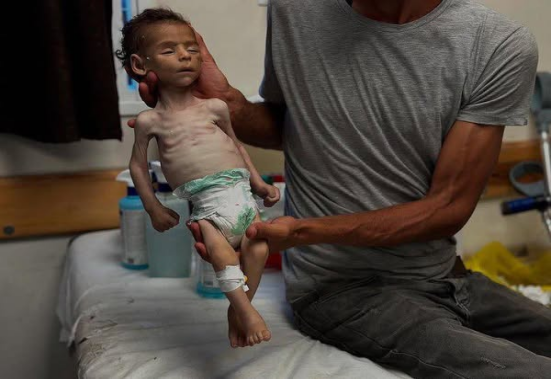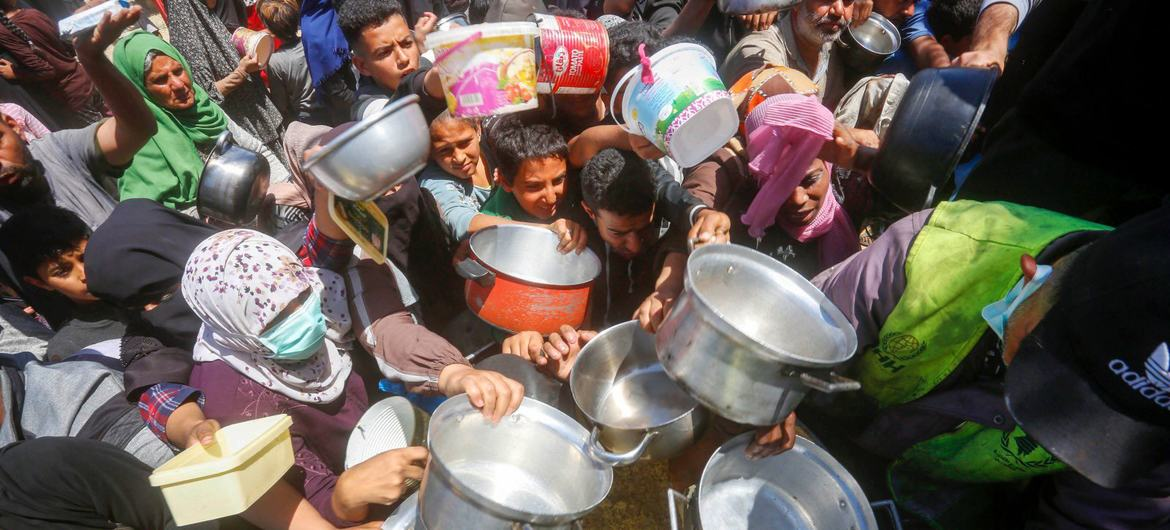Reading time : 3 minutes
- By Reem Al-Haddad
The Gaza Strip is experiencing one of the most severe hunger crises in modern history. Following the complete blockade imposed in early March 2025, humanitarian access has been largely suspended. Food, medical supplies, water, and fuel have become scarce or completely unavailable. This has resulted in widespread acute malnutrition, particularly among children, and a sharp increase in hunger-related deaths.
As of July 2025, nearly the entire population of Gaza, approximately 2.1 million people, faces severe food insecurity, with almost 470,000 people in a state of catastrophic hunger (IPC Phase 5). Without immediate and sustained humanitarian intervention, Gaza is projected to slide into full-scale famine.
Since October 2023, the humanitarian situation in Gaza has deteriorated drastically due to ongoing conflict and repeated border closures. However, the most dramatic escalation occurred in March 2025 when Israel enforced a total blockade on Gaza, halting the entry of food, fuel, medicine, and other essential supplies. This decision came after the closure of the Rafah and Kerem Shalom crossings and was accompanied by intense aerial surveillance and targeting of aid distribution areas.
The resulting humanitarian collapse has led international agencies including the World Food Programme (WFP), World Health Organization (WHO), and UNICEF to raise the alarm regarding Gaza’s descent into famine.
Food Insecurity Overview
According to the Integrated Food Security Phase Classification (IPC), Gaza’s population is experiencing the following levels of food insecurity (as of July 2025):
| IPC Phase | Classification | Estimated Population |
| Phase 5 | Catastrophe/Famine | 470,000 |
| Phase 4 | Emergency | 1,140,000 |
| Phase 3 | Crisis | 500,000 |
This data indicates that 100% of Gaza’s population is in IPC Phase 3 or higher. Nearly one-quarter of the population is currently enduring Phase 5 conditions—characterized by extreme lack of food, hunger-related deaths, and irreversible health damage.
“We do not need a formal famine declaration to act—people in Gaza are already starving.”
- Dr. Tedros Adhanom Ghebreyesus, WHO Director-General
Malnutrition and Health Impact
1.Children

The most vulnerable demographic affected by the hunger crisis is children under five:
10.2% of children screened in Gaza as of June 2025 were suffering from acute malnutrition, nearly double the rate in March.
-69+ children have died due to starvation and dehydration, with the actual toll suspected to be higher due to lack of access to many areas.
-93% of all children in Gaza face crisis-level hunger or worse, according to Save the Children and IPC data.
-Severe wasting, stunted growth, and organ failure are being observed in infants under 12 months.
2.Adults and Elderly
– Starvation-related deaths among the elderly have been increasing due to their inability to compete for food or endure long queues at distribution points.
– In late May, 29 elderly and children were reported dead within 48 hours from hunger-related causes.
– 620+ total deaths have been reported in hospitals from hunger and untreated illnesses since March 2025.

Humanitarian Access and Aid Blockade

Total Siege Since March 2025
Following Israel’s decision to fully seal Gaza’s borders, aid organizations have faced near-total restrictions on bringing in supplies:
-Zero fuel has entered since early March
-Only 40–50 trucks per day have been permitted intermittently—far below the required 500 trucks/day pre-siege.
-Over 116,000 metric tons of food aid remain stuck at entry points, enough to feed 1 million people for 4 months.
– Destruction of Infrastructure
-Bakeries, mills, and food warehouses have been bombed or rendered nonfunctional.
-Agriculture has been decimated; livestock and irrigation systems have been destroyed.
-80% of WFP community kitchens have closed due to lack of fuel and ingredients.
Hunger-Driven Mortality and Violence
Desperation has led to violent scenes at aid distribution points:

On several occasions, Israeli forces opened fire on starving crowds, killing dozens.
-In a notable incident in early June, 32 Palestinians were killed while attempting to access flour in Gaza City.
-Some reports describe stampedes, clashes, and crowd crushes leading to hundreds of injuries.
Socioeconomic Collapse and Food Prices
The economic blockade has made food unaffordable:
| Item | Pre-Siege Price | Current Price (July 2025) |
| Wheat Flour (25kg) | $15 | 800$ |
| Eggs (dozen) | $2.50 | 200$ |
| Rice (1kg) | $1.10 | 79$ |
| Cooking Gas (cylinder) | $12 | Not available |
Smuggling and black-market networks have taken root, driving prices higher and excluding the poorest households from access to basic goods.
Personal Accounts and Eyewitness Testimonies
Numerous testimonials reveal the severity of the crisis:
-“We’re eating grass and animal feed. My daughter asks for bread, and I have nothing to give her.” – Mother of 3 in Rafah
-“We found expired flour and mixed it with water and salt to make something. Then we got sick.” – Elderly man in Deir al-Balah
-“I’ve lost 15kg in two months. My 8-year-old son now weighs 12kg.” – Displaced father in Khan Yunis
Save the Children, UNRWA, and local medical staff describe seeing children’s skin peeling from lack of nutrients and infants dying silently in crowded tents.
The Role of the International Community
Despite repeated calls for humanitarian access, the international response remains inadequate:
-The United Nations has passed multiple resolutions urging for ceasefires and humanitarian corridors.
-International NGOs (e.g., Oxfam, MSF, IRC) have demanded unrestricted aid entry and protection for aid workers.
-Gaza’s Health Ministry and relief organizations have asked for global intervention to prevent “a man-made famine.”
Nonetheless, logistical and political barriers persist, notably:
-Israeli inspections and restrictions on aid convoys.
-Aerial attacks on storage and distribution centers.
-Lack of diplomatic pressure from major global powers to enforce a humanitarian ceasefire.
Outlook and Recommendations
Projected Outcomes (If Crisis Persists)
-An estimated 200,000 additional people may enter Phase 5 (famine) by August 2025.
-Child mortality may double within two months if food and medical access are not restored.
-Long-term cognitive and physical development issues will plague a generation of Gaza’s youth.
Recommendations
The following actions are immediately necessary:
1.Ceasefire & Humanitarian Corridors: Immediate and sustained ceasefire to enable aid flow and prevent further deaths.
2.Unimpeded Access: All border crossings must allow the free and monitored entry of food, fuel, water, and medical aid.
3.Restoration of Local Infrastructure: Support for rebuilding Gaza’s bakeries, water systems, and farms.
4.International Monitoring: Deploy neutral observers to ensure aid reaches civilians safely and equitably.
5.Legal Accountability: Investigate the use of starvation as a method of warfare under international law (Geneva Conventions, Rome Statute).
Conclusion
Gaza is currently facing one of the worst hunger crises of the 21st century. The deliberate restriction of food, combined with infrastructural collapse and conflict-related violence, has left an entire population on the edge of famine. The evidence presented—ranging from malnutrition statistics to first-hand testimonials—underscores the scale and urgency of the disaster.
Without immediate, bold, and sustained intervention from the international community, hundreds of thousands more lives may be lost—not through natural causes but through avoidable, man-made starvation.
The world must act.
Reem Al-Haddad is a freelancer journalist from Gaza Strip.

